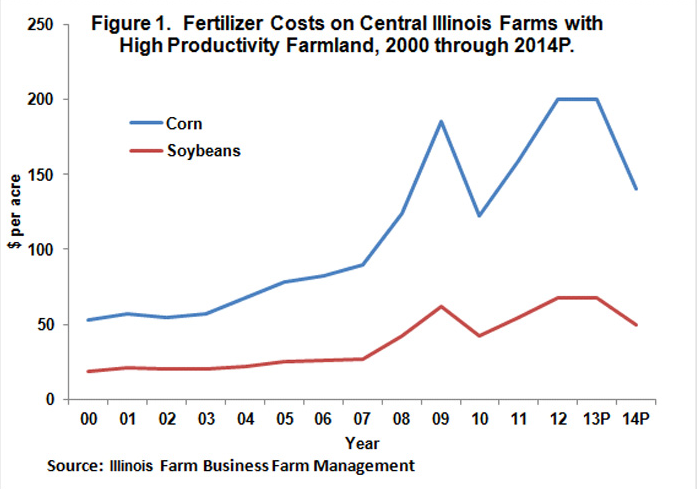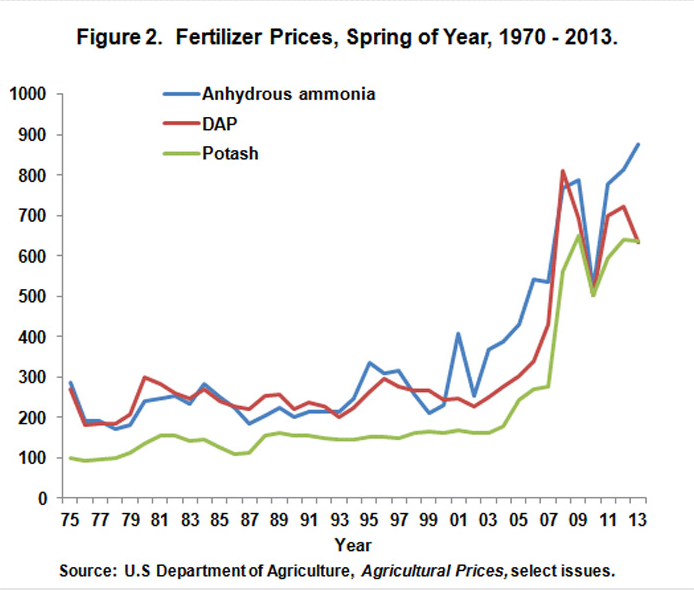From 2006 to 2013, fertilizer costs rose substantially, increasing by 144% for corn and 161% for soybeans. Since September of 2013, fertilizer prices have declined, likely leading to lower fertilizer costs for into the 2014 production year. Even with these cost decreases, evaluating the level of fertilizer applications may be advisable, perhaps lowering application rates given recent price changes.
Fertilizer Cost Increases
For corn grown in central Illinois on high-productivity farmland, fertilizer costs increased from $53 per acre in 2000 up to $82 an acre in 2006, an average yearly increase of $5 per acre. Fertilizer costs increased much more rapidly after 2006. For corn, fertilizer costs were $90 per acre in 2007, $124 per acre in 2008, and $185 per acre in 2009. Because of fertilizer price decreases, fertilizer costs declined to $122 per acre in 2010. From the 2010 level, fertilizer costs rose to $159 per acre in 2011 and $200 per acre in 2012. The 2012 fertilizer cost exceeded 2009 levels and was the highest per acre cost experienced in history. From 2006 to 2012, fertilizer costs increased $118 per acre, a 144% increase from the 2006 level.

|
Fertilizer costs were $26 per acre in 2006. Fertilizer costs in 2012 were $68 per acre, $46 per acre higher than in 2012. From 2006 to 2012, fertilizer costs increased by 161%.
Fertilizer Prices
Rising fertilizer prices largely explained increasing fertilizer prices. The U.S. Department of Agriculture reports anhydrous ammonia, diammonium phosphate (DAP), and potash prices in the spring of each year (see Figure 2). Prices have increased in most years since 2000. Between 2000 and 2013, anhydrous ammonia averaged an 8.2% yearly increase, DAP a 3.7% yearly increase, and potash a 8.6% yearly increase.

|
Now prospects are for significantly lower prices for fertilizer applied for 2014 production. On Jan. 23, 2014, the Agricultural Marketing Service — an agency of the U.S. Department of Agriculture — reported average prices in Illinois of $651 per ton for anhydrous ammonia, $521 per ton for DAP, and $449 per ton for potash. These 2014 prices are below 2013 levels by approximately 27% for anhydrous ammonia, 19% for DAP, and 21% for potash.
Price decreases this large happen rarely. Since 1975, anhydrous ammonia prices decreased more in only three years: -33% in 1976, -38% in 2002, and -34% in 2010. Larger DAP price decreases only occurred in two years: -33% in 1976 and -27% in 2010. Since 1975, a larger decrease for potash price only occurred in one year: -23% in 2010.
While 2014 price declines are large, further downward pressure may exist on fertilizer prices. Additional plant capacity to produce anhydrous ammonia is being placed into operation. Cartel alliances relative to potash have broken up.
Current prices reported by the Agricultural Marketing Service would result in lower fertilizer costs in 2014 as compared to 2013. Using projected price decreases reported above fertilizer costs for corn would be around $140 per acre, down $60 per acre from 2012 levels. Fertilizer costs for soybeans in 2014 would be at $50 per acre, down from $68 per acre in 2012.
Fertilizer Rate Adjustments
While fertilizer cost decreases will occur in 2014, further examination of fertilizer rates may be prudent. Relative price changes between commodity and fertilizer prices may warrant changes.
Lower commodity prices require more of a yield response to justify the application. Take, for example, a fertilizer application that has a cost of $20 per acre. At a $6.50 per bushel corn price, 3 bushel of additional yield are needed to justify the application expense (3 bushel = $20 cost / $6.50 per bushel corn price). A 5 bushel response is needed at a $4.00 per bushel corn price (5 bushel response = $20 per acre / $4 corn price)
However, fertilizer prices also are decreasing and will have the opposite effect of commodity price changes. An application rate that cost $20 per acre in 2013 likely will be around 20% less in costs in 2014.
Overall commodity prices likely will decrease more than fertilizer prices. Corn prices averaged $6.70 in 2013 and likely will be closer to $4.00 in 2014, a 38% decline. As indicated above, fertilizer cost decreases are in the 19% to 27% range. Because fertilizer prices are declining less than corn price, these changes would suggest lower application rates, although fertilizer applications that are the most economical are fairly unresponsive to relative price changes.
Summary
Fertilizer costs likely will decline in 2014, providing some relief from projected lower crop revenues. Fertilizer cost decreases will not be of the same magnitude as crop revenue decreases. Fertilizer costs for corn may decrease by $60 per acre while crop revenue for corn may be down by more than $300 per acre. Evaluation of application rates may be in order given price changes.






Post a comment
Report Abusive Comment